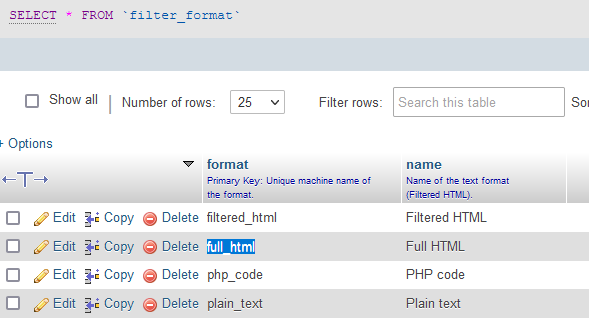I'm not sure I agree with the sentiments, but yes I've read why it's not wanted in core or even listed as a contributed module. I've managed to work around it with editing templates files this far, but I'm currently stuck on something (I'm trying to port a site over that uses webform2pdf - but generates QR codes in that PDF from a separate library.) As far as I've been able to tell, there's no workaround for this particular case.
But that's a whole different problem that wouldn't need solving if I could get the PHP filter working. I've tried porting it over with coder-updgrade and some manual changes after that (admittedly not up my alley, but at least it's a small module.)
Unfortunately, the module seems to rely on making changes to the 'filter_format' directory which existed in Drupal 7, but not in Backdrop. I'm really not a big database guy, but I've done my best to try and find anything similar in Backdrop tables and I can't. I don't mind workarounds (and that'll be my next post) if it's futile, but I think the workaround is too based off what I've tried.
Surely someone has overcome this? There's surprisingly few posts and no resolution on them.
Any help very much appreciated, I have to get past this somehow.


You don't need to do anything with the files "filter.format.xxx.json". Here's what you do (I've verified this).
Begin with your PHP module that you've run through coder_upgrade to Backdropify it.
Comment out or delete function php_enable(). You won't need it. (You can also remove function php_help(), which is now superfluous, but it will be ignored if you leave it in.)
You should now be able to enable the module in Backdrop.
Go to permissions and give the "PHP filter" permission to your super-user (and NOT TO ANYONE ELSE).
Now go to Admin > Configuration > Content Authoring > Text editors and formats > Add text format.
Create a new text format called "PHP filter" and select "PHP evaluator" (plus any other filters needed, like the "Replace tokens" to use the webform tokens) for it. Save configuration. (This will create the new filter config file, so you don't need to worry about that.)
Now you can use this formatter with your PHP code and it should work. Try it out first by creating a Page node with some PHP content.
(I feel a little like I'm explaining how to synthesize nitroglycerine, so let me stress again: be careful with your permissions on who can use this filter, because anyone who can use it can pwn your entire site.)